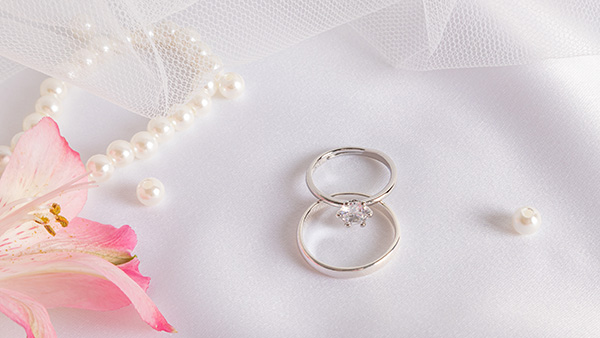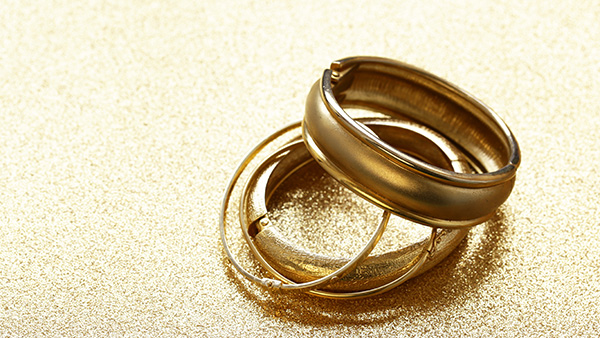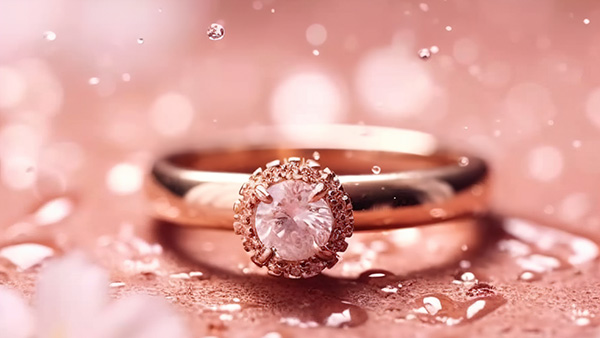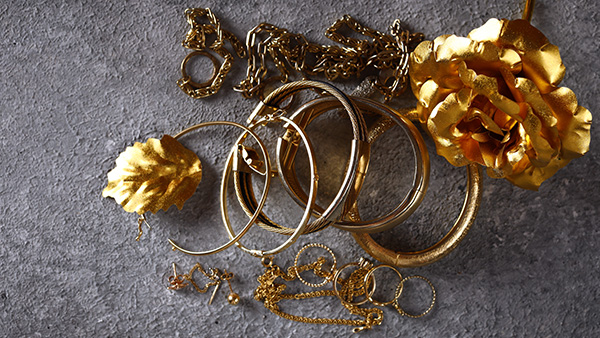All About 24k Gold Jewelry
What is 24k Gold Jewelry?
24k gold jewelry is one of the most sought-after forms of gold jewelry available in the market. The term "24k" refers to the purity of the gold, with 24k gold being the purest form of gold available. Unlike other types of gold, which are often mixed with other metals to create alloys, 24k gold is composed of 99.9% gold. This makes it a highly valuable and precious metal. Due to its purity, 24k gold jewelry is known for its luxurious and rich appearance. However, it is also important to note that 24k gold is a soft metal and can be easily scratched or dented. Therefore, it is commonly alloyed with other metals to improve its durability. 24k gold jewelry comes in various forms, including earrings, necklaces, bracelets, and rings, offering the perfect option for those looking to add a touch of opulence to their everyday wear or for special occasions such as weddings or engagements.
Benefits of Wearing 24k Gold Jewelry
Wearing 24k gold jewelry comes with a plethora of benefits. The pure gold content in these pieces ensures that they exhibit the deep yellow color and bright luster that gold is famous for. This purity also makes 24k gold jewelry highly desirable and sought after.
Not only is 24k gold beautiful, but it is also incredibly durable. Its malleable nature allows it to be shaped into intricate designs without compromising its strength. This makes it perfect for special occasions, such as weddings or anniversary celebrations, as it can withstand regular wear and tear.
Moreover, 24k gold jewelry is timeless in its beauty. Its classic allure adds an elegant touch to any outfit, making it a statement piece that can be cherished for a lifetime. Whether it's a delicate necklace or a stunning pair of earrings, 24k gold jewelry never goes out of style.
Apart from its aesthetic appeal, 24k gold is also believed to have healing properties. It is said to promote positive energy, harmony, and balance in the wearer. Many ancient civilizations recognized the potential therapeutic benefits of gold, and even today, gold is used in medical devices and treatments.
The benefits of wearing 24k gold jewelry are numerous. Its pure gold content, durability, timeless beauty, and potential healing properties make it the perfect choice for special occasions or as a valuable addition to your collection.
Types of Gold Jewelry
When it comes to gold jewelry, there are different types available, each with its own unique qualities and characteristics. The most common types of gold used in jewelry are 14k, 18k, and 24k gold. 14k gold is known for its durability and affordability, making it a popular choice for everyday wear. It contains 58.3% pure gold and is alloyed with other metals to enhance its strength. 18k gold is a higher purity option, with 75% pure gold. It is slightly softer and more malleable than 14k gold, but still suitable for regular wear. Finally, 24k gold is the purest form of gold available, containing 99.9% pure gold. It is soft and easily malleable, making it ideal for intricate designs. However, due to its high purity, it is less durable and more prone to scratches and dents. The choice of gold type ultimately depends on personal preference and budget, with each offering its own unique look and characteristics.
14k Gold
14k Gold, also known as 14-karat gold, is a popular choice for jewelry settings due to its composition and appearance. It is made up of 58.3% pure gold and 41.7% other metals such as copper and silver. This alloy gives 14k gold a bright yellow hue, which is notably more vibrant than the paler color of 10k gold.
One of the key advantages of 14k gold is its perfect balance of durability, affordability, and appearance. The addition of alloy metals makes it stronger and more resistant to scratches and dents compared to higher purity golds like 18k or 24k. At the same time, it remains affordable, making it accessible to a wider range of customers.
The vibrant yellow color of 14k gold also adds to its appeal, giving jewelry pieces a warm and luxurious look. Additionally, the durability of this gold makes it suitable for everyday wear, ensuring that it withstands the rigors of daily activities without losing its shine.
In conclusion, 14k gold is the ideal choice for those seeking a durable and affordable gold option for their jewelry. Its composition and appearance make it a versatile and popular choice for various jewelry settings, allowing individuals to enjoy its beauty and durability for everyday wear.
22k Gold
22k Gold is highly valued and sought after for its high level of purity and fine quality. It is composed of 22 parts gold and 2 parts other metals, resulting in a purity level of 92% gold. While it has a slightly lower purity compared to the purest form of gold, 24k gold, 22k gold is still considered to be one of the most exclusive alloys used in fine jewelry.
The addition of copper or other alloys affects the color of 22k gold, giving it a slightly different hue compared to purer golds. However, this unique color and high level of purity make 22k gold an ideal choice for those looking for exquisite and high-end jewelry pieces.
Whether you're looking for an engagement ring, necklace, or bracelet, 22k gold jewelry is sure to make a statement. Its exceptional level of purity and fine craftsmanship make it a top choice for individuals who appreciate the finest details and quality in their jewelry.
If you're in search of an exclusive and luxurious piece of jewelry, 22k gold is the perfect choice. Its composition and purity ensure that you are getting a piece that is not only beautiful but also of the highest quality.
24k Gold
24k gold is renowned for its purity, making it the purest form of gold available. It contains 99.9% gold, with minimal alloy metals mixed in. This high level of purity gives 24k gold its distinct rich, yellow color that is often associated with gold jewelry.
However, the purity of 24k gold comes at a cost. It is an extremely soft metal, making it impractical for everyday wear. The softness of 24k gold increases the risk of scratches, dents, and other types of damage. This is why 24k gold jewelry is not commonly used for engagement rings or other pieces that are worn on a daily basis.
Despite its impracticality for daily wear, 24k gold is highly sought after for its purity and luxurious appearance. It is often used in special occasion jewelry and as accents in other pieces. Many individuals choose to invest in 24k gold as a store of value, as it retains its worth over time and is considered a precious metal.
While 24k gold may not be the most durable option for everyday use, its unparalleled purity and stunning color make it a perfect choice for those looking for exquisite and one-of-a-kind pieces.
White Gold

White gold is a popular type of gold used in jewelry production due to its unique properties and characteristics. It is created by mixing pure gold with other metals such as nickel, palladium, and zinc, resulting in its distinct white color. This process is known as alloying.
One of the main advantages of white gold is its durability. Unlike pure gold, which is a soft metal, white gold is made stronger and more resistant to scratches and other types of damage through the addition of alloying metals. This makes it more suitable for everyday wear, including engagement rings and wedding bands.
White gold is also highly versatile. It can be crafted into various jewelry designs, ranging from delicate and intricate pieces to bold and statement-making ones. Additionally, white gold pairs well with different gemstones, allowing for endless possibilities in creating stunning jewelry pieces.
Another advantage of white gold is its suitability for those with metal allergies. By alloying pure gold with hypoallergenic metals like palladium, white gold becomes less likely to cause allergic reactions in individuals who are sensitive to certain metals.
White gold offers a perfect combination of elegance, durability, and versatility. Its unique properties make it a popular choice for those who desire a contemporary and fashionable alternative to traditional yellow gold.
Yellow Gold

Yellow gold jewelry is highly sought after for its timeless beauty and classic appeal. Its rich, warm color captures attention and adds a touch of elegance to any ensemble.
Yellow gold is created by alloying pure gold with metals such as copper and silver. This process not only enhances its durability but also gives it distinct characteristics. With a higher percentage of gold content compared to other types of gold, yellow gold jewelry is known for its purity and the deep yellow hue that is instantly recognizable.
One of the key reasons for the popularity of yellow gold in jewelry making is its versatility. It can be shaped and crafted into a wide range of designs, from delicate and dainty pieces to bold and statement-making ones. The softness and malleability of yellow gold allow for intricate detailing and unique finishes, making it the perfect choice for creating intricately designed jewelry.
One of the major benefits of choosing yellow gold jewelry is its timelessness. Yellow gold has been adored for centuries and continues to be a symbol of luxury and sophistication. It has a classic appeal that withstands changing fashion trends, making it a wise investment for those looking for enduring style.
Yellow gold also complements a variety of skin tones, making it a versatile choice for both men and women. Its warm color adds a touch of radiance and complements a wide range of gemstones, making it the perfect choice for creating exquisite pieces of jewelry.
Yellow gold jewelry is loved for its rich color, versatility, timelessness, and ability to complement different skin tones and gemstones. Its enduring appeal and inherent beauty make it a popular choice for any jewelry collection.
Rose Gold

Rose gold, also known as pink gold or red gold, has gained significant popularity in the world of gold jewelry for its unique and trendy appearance. It is created by mixing copper with gold, resulting in a warm and romantic pinkish hue that sets it apart from traditional yellow gold.
The process of mixing copper with gold not only gives rose gold its distinct color, but also enhances its durability. The copper alloy adds strength to the gold, making it suitable for everyday wear. This makes rose gold jewelry a perfect choice for those seeking pieces that are both stylish and long-lasting.
The warm and romantic pinkish hue of rose gold adds a touch of elegance and femininity to any jewelry design. It complements a wide range of skin tones and can be beautifully combined with diamonds and gemstones of various colors. The versatility of rose gold allows for the creation of stunning and eye-catching pieces that stand out from the crowd.
Whether in the form of engagement rings, wedding bands, or other types of jewelry, rose gold is a popular choice among fashion-forward individuals. Its unique and trendy appearance adds a modern twist to traditional gold jewelry, making it a preferred choice for those looking to make a statement.
Rose gold jewelry with its warm and romantic pinkish hue is a perfect blend of tradition and trendiness. Its popularity continues to soar as people seek out unique and stylish pieces that reflect their individuality and personal style.
Properties of 24k Gold Jewelry
24k gold jewelry is renowned for its purity and value. With a gold content of 99.9%, it is the highest karatage of gold available. This makes 24k gold jewelry the purest form of gold jewelry you can find. Due to its purity, 24k gold is naturally a soft metal and can be easily scratched or bent. However, it also possesses an unparalleled beauty and radiance that is unmatched by lower karat gold. Because of its softness, 24k gold jewelry is often alloyed with other metals to increase its strength and durability. Despite being alloyed, 24k gold jewelry still maintains a rich, vibrant yellow color, making it a classic and timeless choice. The high gold content also adds to its luxurious appeal and makes it more resistant to tarnishing or fading over time. When cared for properly, 24k gold jewelry can last for generations, making it a valuable and cherished investment piece.
Purity Level
The purity level of 24k gold jewelry holds significant importance in the world of gold jewelry. As the purest form of gold, 24k gold is considered highly valuable and desirable.
Compared to other common gold purity levels such as 18k and 14k, the purity of 24k gold differs greatly. While 18k gold contains 75% pure gold and 25% other metals, and 14k gold contains 58.3% pure gold and 41.7% other metals, 24k gold is composed entirely of pure gold.
The purity of gold is often indicated by a stamp on the jewelry. This stamp, known as a purity stamp, verifies the gold content in the jewelry piece. For 24k gold jewelry, the stamp will typically read "24k" or "999" to denote its purity level.
The high purity level of 24k gold makes it a sought-after choice for those who value the allure of pure gold. However, it is worth noting that the purity of gold also affects its durability. 24k gold is a soft metal and can be easily scratched or damaged compared to gold alloys such as 18k or 14k.
In conclusion, the purity level of 24k gold jewelry plays a significant role in its value and desirability. Its pure gold composition sets it apart from other common purity levels, and purity stamps on gold jewelry serve as an important indicator of gold content.
Color & Sheen
When it comes to color and sheen, 24k gold jewelry boasts a distinct and eye-catching appearance. Due to its high content of pure gold, it showcases a vibrant orange-yellow hue that is truly captivating. This rich color sets 24k gold jewelry apart, making it instantly recognizable and highly desirable.
However, it's important to note that 24k gold cannot be alloyed with other metals to create different colors like white gold or rose gold. These alternative colors are achieved through the addition of alloys, which are mixed with lower purity golds like 18k or 14k. So, if you're looking specifically for white or rose gold jewelry, you may need to consider lower purity options.
That being said, there are still various colors available in gold jewelry beyond the traditional yellow. Common options include white gold, which has a silvery appearance achieved by alloying gold with metals like palladium or silver, and rose gold, which incorporates copper to create a warm rosy hue.
Furthermore, artisans and jewelers have also explored more unique and unconventional colors in gold jewelry. Through the use of patinas or oxides, they have achieved intriguing tones like blue or purple, adding an extra layer of creativity to the world of gold jewelry.
In summary, while 24k gold jewelry showcases a stunning orange-yellow color and boasts a radiant sheen due to its high purity, it is limited in terms of the color options it can offer. If you are seeking a white or rose gold piece, considering lower purity options would be necessary. However, there are still a wide range of colors available in the world of gold jewelry, including the more unusual hues achieved through innovative techniques and materials.
Durability & Wearability
Durability and wearability are important factors to consider when choosing jewelry, and 24k gold has certain characteristics that may affect its suitability for everyday wear. While 24k gold is prized for its high purity, with 100% gold content, it is also known for being a soft metal. This softness makes it more susceptible to scratches and dents compared to lower purity golds like 18k or 14k.
Due to its softness, jewelers often do not recommend using 24k gold for everyday wear, especially for pieces like engagement rings or wedding bands that are subject to frequent use and potential impact. The softness of 24k gold makes it more prone to wear and damage over time, affecting its longevity and overall appearance.
It's also important to note that 24k gold can be easily bent or easily scratched, which may not be ideal for those who are looking for a durable and long-lasting piece of jewelry. For these reasons, lower purity golds like 18k or 14k are commonly used for everyday jewelry pieces, as these alloys offer a good balance between durability and gold purity.
It's also worth noting that while 24k gold is less susceptible to tarnishing compared to lower purity golds, it can still be tarnished when exposed to certain chemicals like bleach. So, it's important to take proper care and avoid exposing 24k gold jewelry to harsh chemicals or cleaning agents. Overall, while 24k gold jewelry is prized for its purity, it may require extra care and maintenance due to its softness and susceptibility to scratches and dents.
Price Point
When it comes to price point, 24k gold jewelry is typically more expensive than other types of gold due to its higher gold content. The purity of 24k gold, being 99.9% gold, makes it the purest form of gold available. However, this higher gold content comes at a cost.
To understand the value of 18k gold, you can calculate it by multiplying its pennyweight by 0.750 and dividing the current spot gold price. This formula gives you the approximate value of the gold in the jewelry.
For 24k gold, the value is calculated slightly differently. You divide the current spot gold price by the pennyweight of the product. This calculation gives you an estimate of the value of 24k gold.
An interesting fact about gold prices is that, in late 2011, they rose above platinum prices. This occurrence highlighted the enduring allure and value of gold as an investment and a luxury item.
In conclusion, 24k gold jewelry is considered an expensive type of jewelry due to its higher gold content. Its value can be calculated by dividing the current spot gold price and multiplying it by the pennyweight of the product. This precious metal has held its position as a symbol of wealth and luxury throughout history.
Alloys and Other Metals Used in Production
In the production of 24k gold jewelry, alloys and other metals are often added to enhance durability and wearability. While 24k gold is pure and lustrous, it is also a soft metal that can easily scratch and deform. Hence, the addition of alloy metals becomes necessary to create a more resilient piece of jewelry.
Common metals used as alloys in 24k gold jewelry production include copper, iron, silver, zinc, and nickel. These metals are mixed in precise proportions with the pure gold to create a new alloy. The introduction of these alloy metals not only makes the gold jewelry more durable but also allows for customization in terms of color and strength.
Alloying gold with copper, for example, creates a warm pink shade better known as rose gold. On the other hand, adding silver or palladium results in white gold, creating a contemporary and elegant look. These alloys enhance the versatility of the jewelry, making it suitable for a wider range of occasions and ensembles.
Moreover, alloying gold also serves the purpose of making the jewelry more affordable. As 24k gold is the purest form of gold, it is relatively more expensive. However, by adding alloy metals, the gold content decreases, which subsequently reduces the overall cost without compromising on the quality or appearance of the jewelry.
In conclusion, the addition of alloys and other metals in the production of 24k gold jewelry is essential for durability, wearability, customization, and affordability. These alloys enhance the strength and longevity of the jewelry while allowing for a range of color options. It is through the careful combination of metals that gold jewelry becomes not only a luxurious accessory but also a practical and accessible choice for everyday wear.
